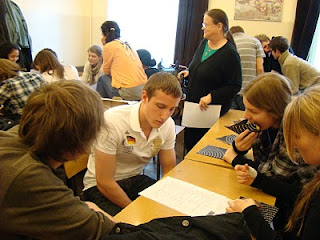

When we  were driving to Auschwitz last week, as Eva told us about the death of President Lech Kaczynski, she alluded to John Donne's famous "Meditation 17" in which he states, "Ask not for whom the bell tolls; it tolls for thee." Today, we touched the famous bell in the tower of Wawel Cathedral, which rang on Sunday, the day of Kacynski's funeral mass and burial in the crypt inside Wawel. The belief here is that by touching the clapper of the bell and making a wish, the wish will come true. Most of our group probably wished to go home as soon as possible; however, due to our extended stay, we had another wonderful day in Krakow, thanks to Eva, our guide.
were driving to Auschwitz last week, as Eva told us about the death of President Lech Kaczynski, she alluded to John Donne's famous "Meditation 17" in which he states, "Ask not for whom the bell tolls; it tolls for thee." Today, we touched the famous bell in the tower of Wawel Cathedral, which rang on Sunday, the day of Kacynski's funeral mass and burial in the crypt inside Wawel. The belief here is that by touching the clapper of the bell and making a wish, the wish will come true. Most of our group probably wished to go home as soon as possible; however, due to our extended stay, we had another wonderful day in Krakow, thanks to Eva, our guide.
 were driving to Auschwitz last week, as Eva told us about the death of President Lech Kaczynski, she alluded to John Donne's famous "Meditation 17" in which he states, "Ask not for whom the bell tolls; it tolls for thee." Today, we touched the famous bell in the tower of Wawel Cathedral, which rang on Sunday, the day of Kacynski's funeral mass and burial in the crypt inside Wawel. The belief here is that by touching the clapper of the bell and making a wish, the wish will come true. Most of our group probably wished to go home as soon as possible; however, due to our extended stay, we had another wonderful day in Krakow, thanks to Eva, our guide.
were driving to Auschwitz last week, as Eva told us about the death of President Lech Kaczynski, she alluded to John Donne's famous "Meditation 17" in which he states, "Ask not for whom the bell tolls; it tolls for thee." Today, we touched the famous bell in the tower of Wawel Cathedral, which rang on Sunday, the day of Kacynski's funeral mass and burial in the crypt inside Wawel. The belief here is that by touching the clapper of the bell and making a wish, the wish will come true. Most of our group probably wished to go home as soon as possible; however, due to our extended stay, we had another wonderful day in Krakow, thanks to Eva, our guide.

 We were welcomed by teachers and students at a university preparatory high school, V Liceum Ogolnoksztalcace im. Augusta Witkowskiego, established in 1871 by Franz Joseph I. We attended two English classes, during which our students conversed with the Polish students and asked questions about each others' culture. We also viewed a safety demonstration, and toured the biology classroom, which was complete with a Nemo fish and a chameleon, among many other habitats and live animals. The teachers gave us all Krakow donuts, which they said were the equivalent to Dunkin Donuts. They actually were better: a little less sweet, and a little more substantial, with raspberry filling.
We were welcomed by teachers and students at a university preparatory high school, V Liceum Ogolnoksztalcace im. Augusta Witkowskiego, established in 1871 by Franz Joseph I. We attended two English classes, during which our students conversed with the Polish students and asked questions about each others' culture. We also viewed a safety demonstration, and toured the biology classroom, which was complete with a Nemo fish and a chameleon, among many other habitats and live animals. The teachers gave us all Krakow donuts, which they said were the equivalent to Dunkin Donuts. They actually were better: a little less sweet, and a little more substantial, with raspberry filling. 



We spent the afternoon touring Wawel Castle, which dates back to the middle ages, and was restored completely in the early 20th century before World War II. We admired the many fabulous, elaborate tapestries which were woven in the 16th century, along with paintings and furniture from the renaissance time period. 

Going into Wawel Cathedral, we walked past the wreaths of flowers from different countries that were sent for the funeral of President Kaczynski. Inside, we saw the sarcophagi of many Polish kings, queens, and important Polish leaders. Most surreal, however, was walking through the crypt with the sarcophagus of President and Mrs. Kaczynski, viewing the cold marble, the golden inscription, and the etched cross on the top. After watching the funeral on CNN and being in the streets of Krakow during the funeral procession, actually descending the steps into the crypt felt eerie. Here we were, in line with other Polish citizens, touching the sarcophagus, and mourning the death of their leader with them.


"Ask not for whom the bell tolls; it tolls for thee." How fitting for us, teachers and students seeking history, seeking the truth about the Holocaust and the past. Living history in the present, and creating memories of a lifetime.







































